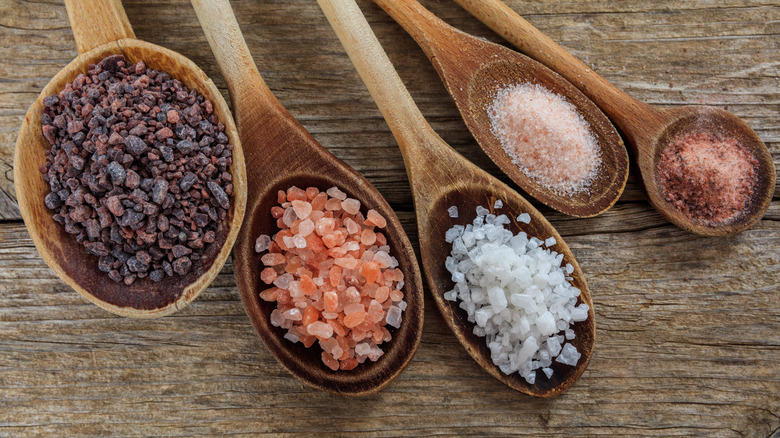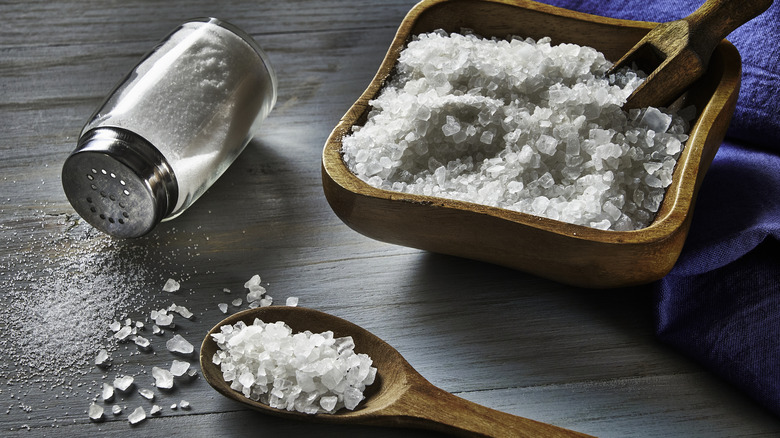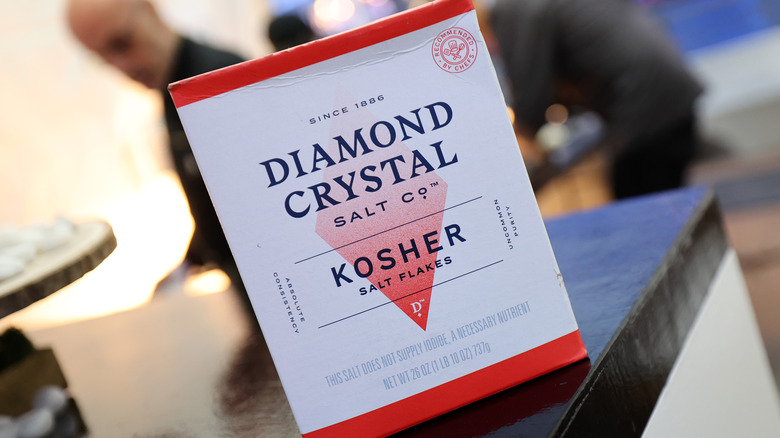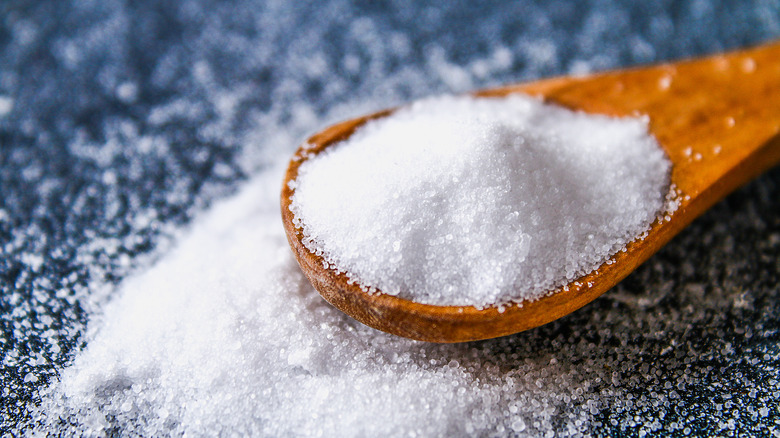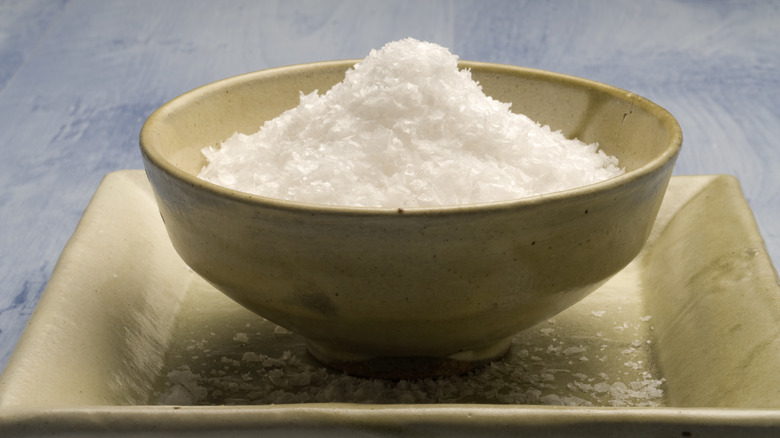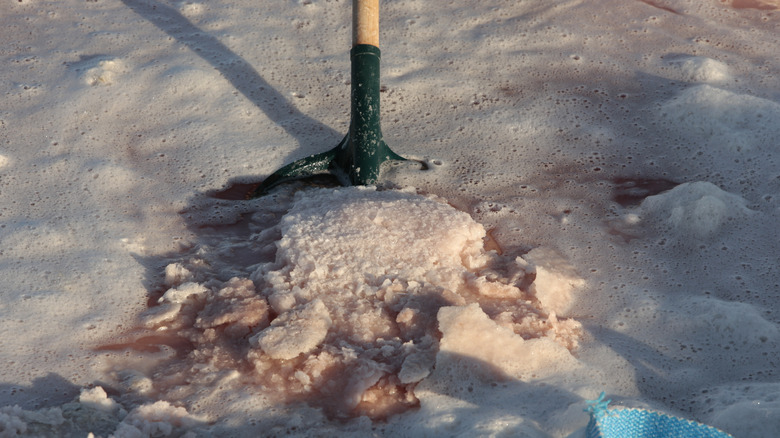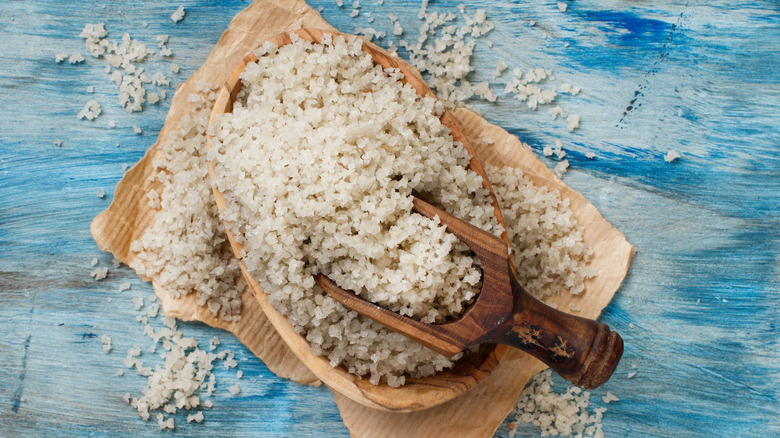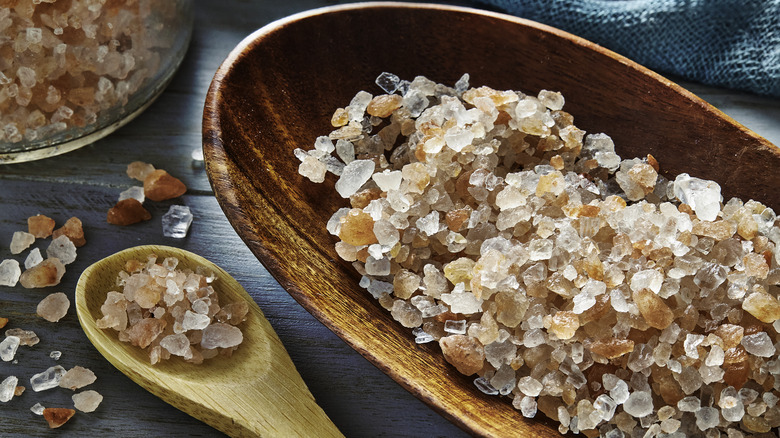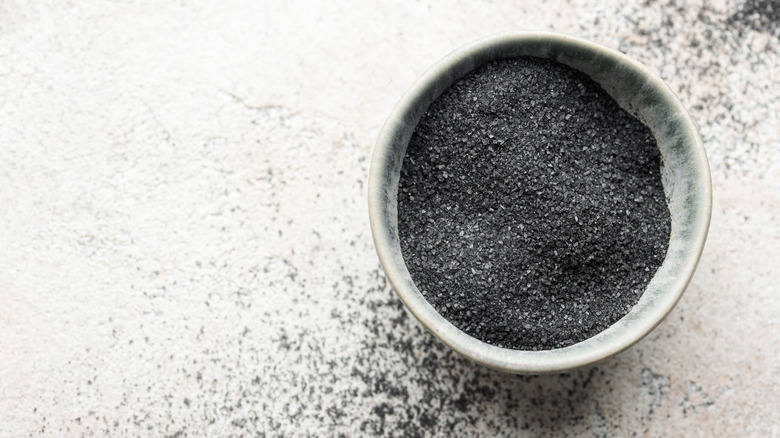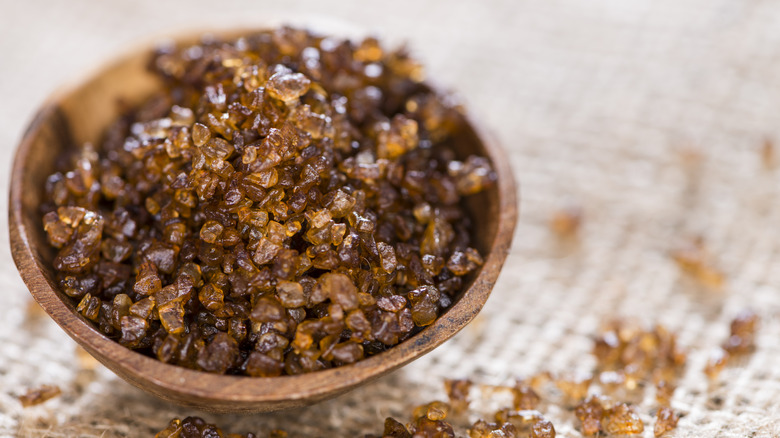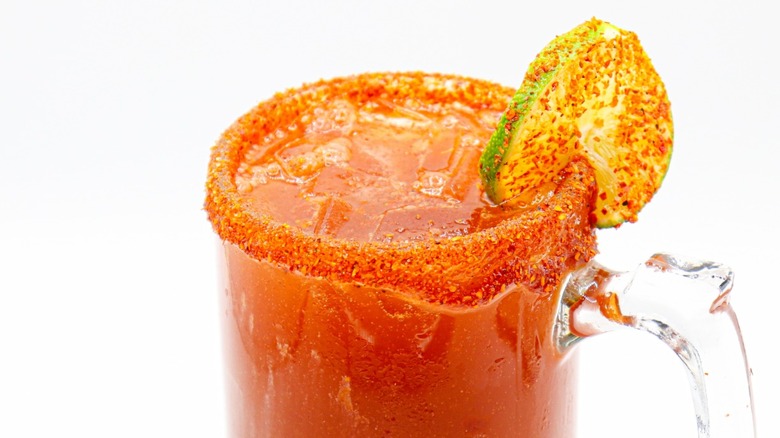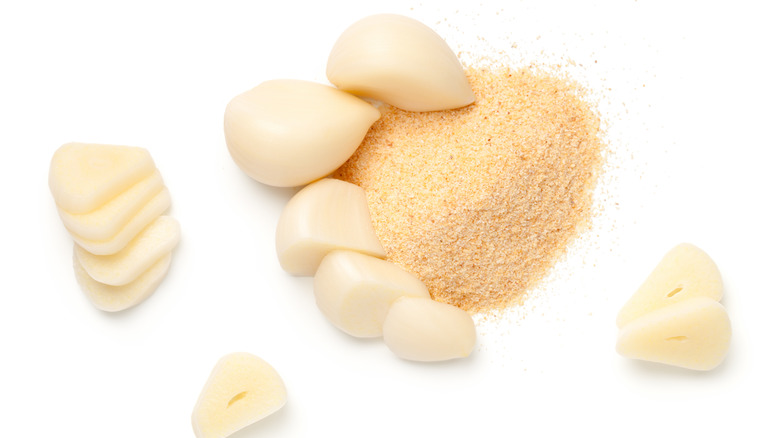The Best Salts To Stock Your Pantry And Make Your Food Taste Amazing
Salt is an essential ingredient that enhances the natural flavors of nearly every other food. Too much can be bad for us, but the right amount is essential and can make a dish sing. There are many different types of salt, and it's worth knowing what's what. From where the salt comes from, to how it's harvested, to the size of the salt crystals, different salts have different origins and ideal uses. Not all salt is created equal, and in fact, some salts even taste saltier than others.
Certain brands have become household favorites and restaurant staples for a reason. Products like Diamond Crystal kosher salt and Maldon Flaky sea salt have near cult followings. You'll find quite a range of prices, from simple table salt to fancy fleur de sel, but knowing the basic principles of how to cook with different salts can help you upskill in the kitchen regardless of your budget. Finer salts will dissolve quicker, taste saltier, and work well for baking and seasoning, while larger flake salts are better for finishing prepared dishes. Knowing which kind of salt to use for which purposes can revolutionize your cooking.
Sea salt vs. rock salt
All salt is either harvested from evaporated seawater or mined from the earth. It can come in delicate flakes, chunky rocks, or finely ground almost to a powder. All kinds are essentially the same chemical composition, sodium chloride, but some salts naturally contain other minerals which can affect the taste and color while others are treated to add or remove those minerals. Are your salt crystals perfectly even-shaped and white? Or have you ever noticed a lovely pink or gray hue? That'll be caused by the presence of additional minerals found where the salt was harvested.
While many companies would have you believe that their brand of salt offers additional health benefits, there isn't much discernible difference between their respective health properties. While some salts do contain additional minerals, they're usually not present in high enough quantities to have a real effect. So when selecting your salt, it's not really about whether one is "healthier" — it's more about selecting the salt with the flavor palette and crystal size that work best for the task at hand. Broadly speaking, there are salts to cook with, and salts to "finish" with. These are introduced at different stages of the cooking and serving process. Salt brings out the flavor of foods, and you can season at each step of preparation.
Kosher salt
Kosher salt is a must-have in any kitchen and should be used during the cooking process to season meat and salt water. You'll often see professional cooks liberally seasoning food with kosher salt, rather than table salt. The typically larger crystal size makes it less salty on the tongue and easier to see how much you have applied. Red meats can be liberally salted a day ahead to properly season the meat, even two days ahead for larger cuts. Chicken can also be salted in advance whereas delicate fish or vegetables should only be salted closer to cooking time.
Many chefs prefer Diamond Crystal kosher salt when it comes to seasoning their dishes. It's less salty than the common competitor, Morton (which is almost twice as salty!) and therefore easier to sprinkle liberally over a steak or roast. Diamond Crystal's salt crystals are less dense, more hollow, making them easier to break down as well. A longtime favorite in professional kitchens, it's typically sold in larger boxes. But, according to the New York Times, home cooks' demand for Diamond Crystal skyrocketed during the pandemic. The salt is now more readily available for retail purchase. A 3-pound box will run you a little over $13 on Amazon.
Table salt
Table salt is one of the most common salts you'll come across. Found in kitchens and dining rooms across the country, it's one of the finer salts and therefore works best in your salt shaker. Smaller, denser crystals make saltier salt, so don't dole it out quite as liberally as you would kosher salt. Table salt is often the preference for baking, however, due to its uniform crystal size which makes it easy to measure out exactly. When it comes to this pantry staple, Morton's table salt is a go-to. It's cheap and readily available at pretty much any grocery store or online; a bundle of two 26-ounce containers costs nearly $12 on Amazon.
This salt won't look like it's just been carved out of a mountain or scraped from the sea as it's usually processed to remove additional minerals. However, table salt can be "fortified" with specific compounds and may contain anti-caking agents that keep the crystals from taking on moisture and sticking together. Table salt is typically iodized, which means potassium iodide or potassium iodate has been added to the salt. This practice began in the 1920s when scientists discovered that many people were suffering from iodine deficiency which commonly resulted in hypothyroidism and goiters, among other symptoms. Experiments to see how introducing iodized salt would affect the population quickly revealed that these adverse health effects could easily be reversed. To this day it remains common practice to iodize table salt in many countries around the world.
Flaky sea salt
Flaky sea salt is another staple for any avid home cook. Large flat crystals make this salt less salty on the tongue and perfect for finishing dishes just before serving. The flake size provides a little crunch that will add texture as well as flavor. You'll probably want to pinch the salt and sprinkle it with your fingers to break up the larger pyramid-shaped crystals a little, rather than spooning it out.
Made since 1882 in Maldon, England, Maldon Flaky Sea Salt is a tried and true favorite. If you're struggling to find Maldon at your local grocery store, a 20-ounce box is available for $14.49 on Amazon. That box of Maldon Flaky Sea Salt isn't exactly cheap, but it is more affordable than its rival, fleur de sel, and it's well worth the investment.
Don't waste your flaky salt salting pasta water or marinating a steak, as those are jobs for kosher salt. Instead, reserve your flaky salt for garnishing, and a box will last you quite a while. The addition of Maldon salt will elevate your spread considerably. Meat and veggie dishes alike benefit from a pinch of Maldon. It's also perfect when sprinkled liberally on top of a freshly baked focaccia. You can even enhance chocolate chip cookies and other desserts with a little pinch of flaky sea salt, as salt can actually bring out sweetness.
Fleur de sel
Considered the champagne of salts, fleur de sel is probably the most expensive salt you can stock in your pantry. While the price may be high, many consider it worthwhile to keep some on hand for its unique flavor and delicate texture. Le Saunier De Camargue is Ina Garten's salt of choice. At nearly $10 for 4.4 ounces on Amazon, this salt should certainly only be used to garnish.
Fleur de sel is partly so pricey because of the labor-intensive way the delicate sea salt has been harvested by hand for centuries from the crust that forms on the surface of the sea as water evaporates. Traditionally harvested in France off the coast of Brittany, it is now produced in several other countries such as Greece, Spain, and Portugal. The relatively higher moisture content present in the resulting salt creates its snowflake-like texture. Fleur de sel melts more quickly than other sea salts. It also contains other minerals that enhance the flavor of the salt. Fleur de sel is sometimes paired with sweets like luxurious caramel.
Celtic sea salt
Celtic sea salt is an unrefined sea salt that's typically harvested from the coastal regions of France, though now harvested in other locations as well. Also known as "sel gris," it is often light gray in color and has a brinier flavor resulting from its ocean origins. As opposed to fleur de sel, which is combed from the top of the sea, Celtic sea salt is raked from the seafloor. It's less delicate than flaky sea salts, but its slightly moister texture and particular flavors make it a nice finishing salt.
The Celtic Sea Salt brand, started in 1976, is widely available and much beloved. It is available for purchase in larger or finer ground crystals. Currently $12.70 for 8 ounces on Amazon, its price reflects the process by which it is harvested. The company boasts additional health benefits of its mineral-rich salt, and many agree, but you can take that with a grain of salt, as it were. One thing can't be denied, it's less processed than many alternatives with a unique flavor profile and texture and certainly a great option to have on hand.
Himalayan salt
A natural alternative to table salt, Himalayan salt can contain traces of calcium, iron, magnesium, manganese, potassium, aluminum, barium, silicon, and sulfur. It's also got a reputation for having certain health properties, though this claim is dubious. Himalayan salt is mined in the Salt Mountains of Pakistan. This pretty salt often has a natural pink color due to the presence of other minerals. This makes it look especially lovely in an open pinch pot on your table as an alternative to table salt in a shaker, but the color won't translate into cooked dishes when the crystals break down. Some say it pairs well with chicken, but you may even find bricks of it at the spa in a sauna or as the body of a lamp with a lovely pink glow.
There's lots of Himalayan salt on the market; even Morton sells it. It'll cost you more than garden variety table salt, but Amazon's overall pick, Soeos brand fine grain pink Himalayan sea salt, is just $9.99 for 2.4 pounds. Himalayan salt can be used for cooking and baking and comes in fine and coarse varieties. As with table salt, be careful not to over-salt with the finer Himalayan salt. Taste as you go to make sure you've hit the perfect level.
Black lava salt
If you want to make a statement with your salt, black lava salt will do the trick. Coarse, shiny, and yes, black, despite its name, this traditional Hawaiian salt is not actually made from lava. Rather, black lava salt is made by blending sea salt with activated charcoal. The charcoal can be made from burnt coconut shells.
Black lava salt is beautifully decorative and would be largely wasted if cooked or baked into a dish, where its distinguishing color would dissolve. It is a finishing salt with a unique appearance and an earthy, smoky flavor that looks great sprinkled on top of a lighter-colored dish or simply placed on the table in a pinch pot for your guests to season their food. Viva Doria is Amazon's overall pick at just $14.99 for 2 pounds.
Smoked salt
Flavored salts are another great option for seasoning your food at the finishing stage. Smoked salt is made by smoking sea salt over wood chips. The salt crystals take on the flavor of the particular wood smoke and turn a lovely shade of brown. The resulting smoky flavor pairs well with many foods, particularly barbecued meats, fish, and roasted vegetables. You may even like to try a little pinch garnished on your next cocktail. Perhaps a smoky mezcal margarita.
Maldon Flaky Sea Salt makes a smoked version that has become a favorite in many kitchens. That same signature Maldon crunch is enhanced by the flavor of oak wood smoke. It's sold for $7.49 for 4.4 ounces on Amazon. The flavor is strong, though, so make sure to taste before adding it to just anything, and be careful not to swap it out for your regular flaky salt when sprinkling some on your next batch of cookies ... unless you feel like experimenting, of course. Smoked salted caramel? Why not!
Chili lime salt
Chili and lime are a classic flavor combination in Mexican cuisine. Chili lime salt is a fairly common seasoning blend of salt, dehydrated lime, and chili that brings those flavors to the table. A zesty favorite, Tajín is the most famous brand today. Originating in Mexico in 1985, it made its way into the U.S. market in the 90s and remains an essential cupboard item to this day. It is commonly available and you might very well find Tajín at your local grocery store. If it's not in stock, however, it's easy to order online for a reasonable price.
Tajín tastes great on savory dishes like nachos, quesadillas, or tacos. But it's not uncommon to find it sprinkled over fresh fruit and vegetables as well. The vibrant chili and lime flavors bring out the sweetness of mango, pineapple, or watermelon. You can also rim a glass with Tajín for a michelada, a spicy margarita, or a chamoy mango slushy on a hot day. Or even try shaking some onto your next bowl of popcorn for an extra kick of tangy flavor.
Garlic salt
Garlic salt is another common seasoning salt you may already have in your pantry. Dehydrated granules of garlic are mixed with fine salt crystals for a punchy, flavor-packed seasoning. You can incorporate garlic salt into sauces, chilis, and other braised dishes. It also works in marinades or simply season pan-fried or grilled meats and seafood. Garlic salt is a great shortcut to shrimp scampi or garlic bread when you don't have the fresh stuff on hand. Stir it into melted or softened butter and get cooking.
There are several brands of garlic salt on the market, some incorporating organic garlic at a higher price point. You can even make your own with garlic granules and your favorite salt. Most grocery stores will keep it front and center in the spice aisle and likely have several different brands for you to choose from, McCormick being one. And if you can't find it there, it's just as easy to find online.
